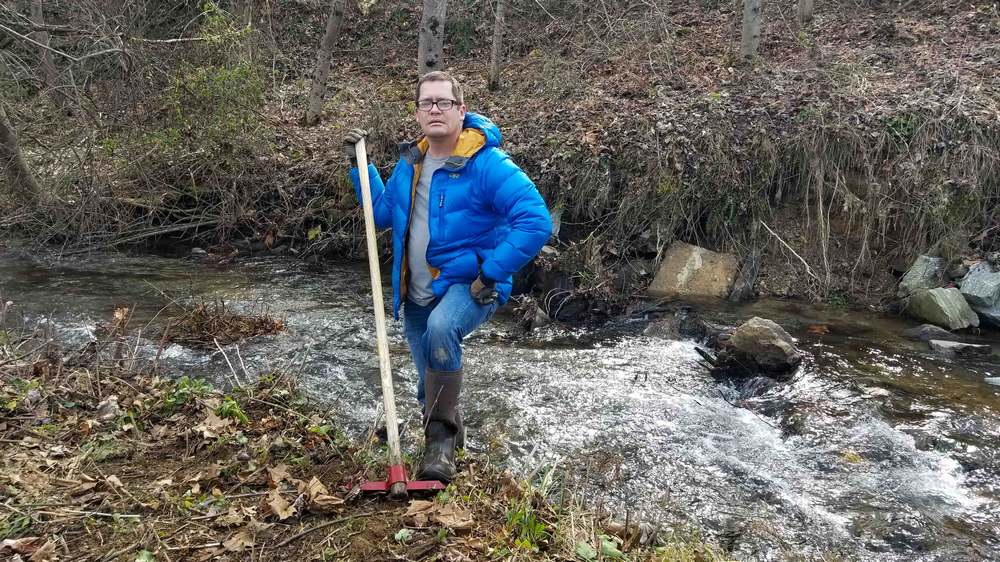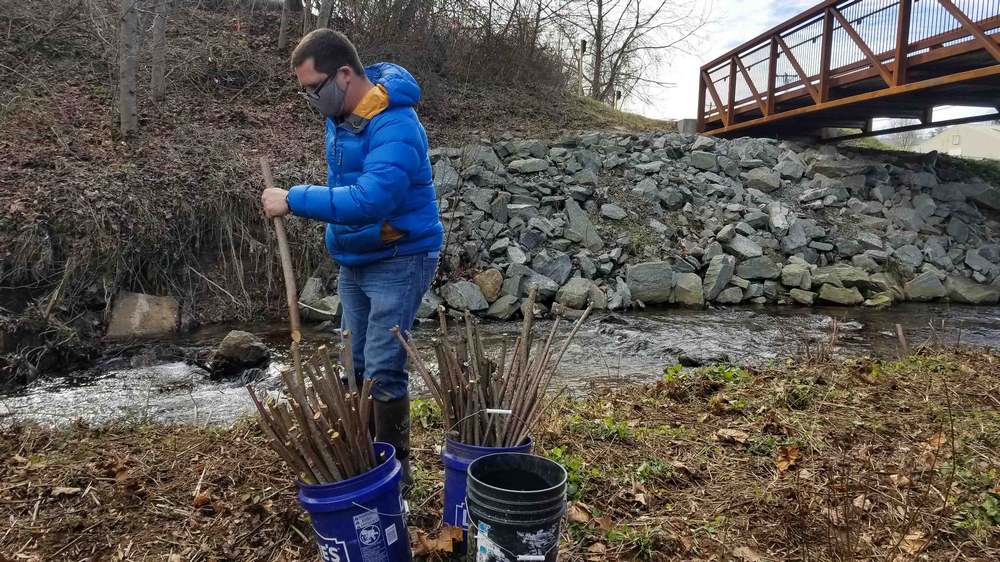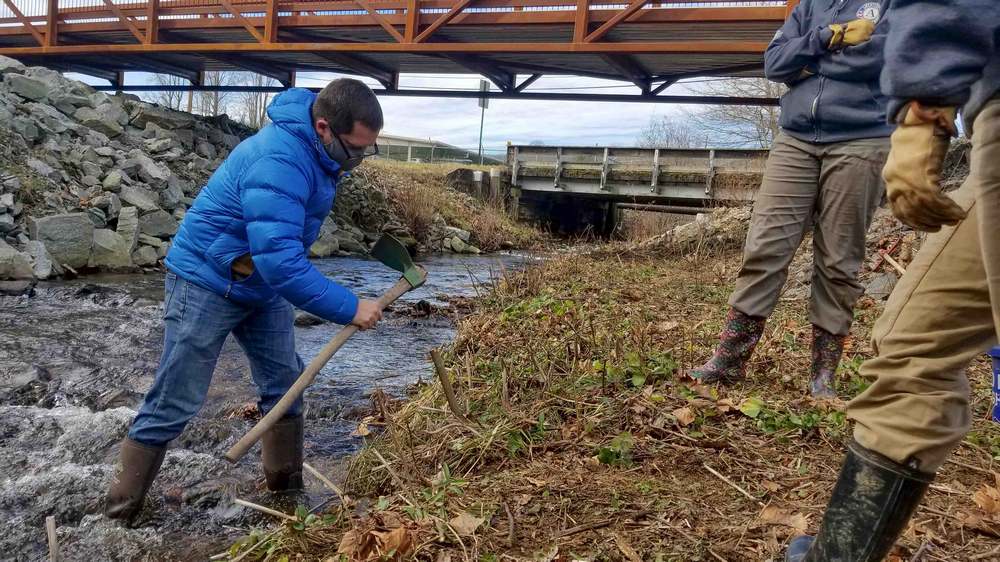Free Trees! Act now while the time is right!
Learn how to live stake native trees from our conservation easement manager, Torry Nergart
Now that I have your attention, how about reading on to learn an easy way to propagate western North Carolina native plants? In particular, some free trees and shrubs that provide shade, flowers, fruits, erosion prevention, wildlife habitat, food, medicine, even wine?

When and Why to Live Stake Native Trees
The very low-tech, low-cost propagation method I’m referring to is called “live-staking.” And by propagation, I mean in the horticultural sense of just plain old making more of a certain kind of plant, and propagation in the sense of “widely promoting and distributing and idea” both per Webster. See, just the action of planting native plants helps uplift the known fact that native plants are more resilient in the garden and landscape and provide greater ecosystem services (habitat, food, other benefits for all life forms). To top off the list of benefits, making more native plants is downright cheap if not totally free.
To do live-staking, you’ll need a donor plant of certain species, a hand pruner, a mallet, a bucket, and a place to plant. So maybe not exactly free, but maybe borrow some tools, and find a friend with native plants in their garden? Ask for help from your friendly neighborhood Conservation Easement Manager? However you go about it, now in the trough of winter (late January-February-March-even into early April) is the exact right time to be live-staking.

How Live Staking Works
What we are taking advantage of is the plant’s ability to be hardy against the constant barrage of competing forces in Nature: animals eating them, being blown over in a hurricane, wayward youths carving their everlasting love monument into them, all sorts of damaging events. To counter all this since they can’t run away, plants have undifferentiated cells concentrated around places they need growth; the tips, roots, and buds. Those groups of cells are called meristematic tissue, and plant hormones called auxins trigger growth where needed in response to environmental stimuli. Those meristematic cells can become new branches or roots depending on what the plant needs most.
The stimulus plants get during live-staking is by whacking off a 2-3’ section branch having several buds and then jabbing it into the ground. I said low-tech, right?
What Kind of Trees Can You Live Stake?
There are some finer points, this is not total herbicidal barbarism. First you’ve got to pick the right plant. Silky Dogwood, Black Willow, and Elderberry (Cornus amomum, Salix nigra, Sambucus canadensis) are my top three choices for live-staking. I’ve put them in order of best ability to take to root. Mountain Pepperbush (Clethra acuminta) will take to live-staking though not as well, and Buttonbush (Cephalanthus occidentalis) too but has to be planted in wetlands.
Let’s focus on the big three though. They’re all common to the mountains and quite abundant.
Silky Dogwood has lovely maroon twigs, large heads (umbels) of white flowers that bees love, and black berries that birds enjoy.
Black Willow is a major food source (aka host plant) for the caterpillars of Tiger Swallowtail, Mourning Cloak, Viceroy, and Red-spotted Purple butterflies.
Elderberry has lovely umbels of edible white flowers, and the fruits in addition to being excellent bird food, is edible by humans as well. A common way to eat Elderberry is by drinking a syrup, which in clinical trails shows efficacy in treating and preventing influenza. My granny was known to make a very good wine from the juice as well! I’ve kept that tradition, though some years it is difficult to harvest enough- the birds really do pursue Elderberry first, and they’ve got 24/7 to be a bird, I’ve only got scant spare time to be a brewer.

How to Live Stake Native Trees
Now that we’ve got the right plant, we need the right technique. Using sharp and clean hand pruners or loppers, cut a ½” to 1 ½” wide and a 2-3’ long section of branch. Look for healthy wood, with several buds and no damage (cankers, wounds, fungus). Remember those hormones called auxins? Now the donor plant is going to respond by sprouting new branches, so don’t worry about the poor little tree. If you’re not going to plant right away, the stakes can be stored in a bucket with water for several days, as long as they’re kept cool.
Remember which end is up! Make the best effort to ensure this, it’ll never work when the plant is upside-down! Make a slanted cut on the bottom, and a flat cut on the top.
Next locate a suitable spot. All three prefer more moist soils, like along a streambank or bottomland. They’ll all grow in less desirable spots, but may need more coaxing- I’ve staked Elderberry into pots for later transplant with success, I just buried the pots during the rooting period (a technique called pot-in-pot). I’ve also had Black Willow root in the bucket, after about a week of soaking (I accidentally forgot a bucket behind the tool shed once). Willow can be staked at any time of year, but better success is had now.
Now for the staking- take that rubber mallet and hammer the branch into the ground, about halfway or just past. Please try not to take out your worldly frustrations here, you don’t want to damage the stake- Elderberry is the softest of the three, having a spongy pith in the middle. That’s it, you’ve just live-staked! Free trees!
If you want any extra help, please feel free to contact me at [email protected]. A good portion of my work is providing technical assistance in natural resources management, not just to conservation easement landowners but to my whole Transylvania community. I and our network of conservationists, native plant gardeners, botanists, environment restorationists, friends, and neighbors are all here to help. This network has access to tools and donor plants, plenty of experience, and most of all enthusiasm to get out and make more trees!
Torry Nergart is the Conservation Easement Manager for Conserving Carolina. This column was originally published in the Transylvania Times.